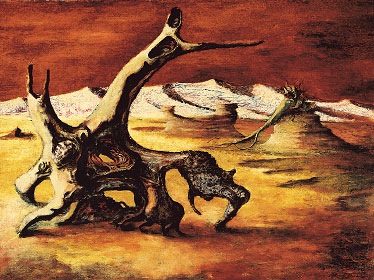- What’s it like being the only vet in a country? The BBC tells us.
- The CBD on how to be a good pastoralist.
- James does a mini-roundup of the India GM brinjal to-do.
- Mapping the fast food culture.
- Mexico wants Unesco to recognize culinary traditions. As if tamales were in danger of extinction. Didn’t France ask for the same last year?
- Heirloom chickens don’t taste like chicken.
- Deconstructing the cultural significance of the colour of corn.
- “GM crops: still not a panacea for poor farmers.” In other news, still no cure for cancer.
Nibbles: Artichoke, Barley, Aquaculture, Organic farms, Pig conservation, Involuntary parks, Chokeberries, Grass evolution, sustainability
- Jeremy says: Put an artichoke in your tank!
- American boffins say: I know what, instead of making beer with it, let’s feed barley to fish.
- Ugandan fishermen say: Want a “boutique” fish?
- USDA says: “The nation’s organic farms and ranches have higher average sales and higher average production expenses than U.S. farms overall…”
- South African animal genetic resources experts say: Save our pigs!
- The Economist says (we paraphrase) war is good for biodiversity conservation … but where are the wild relatives?
- Right here, in the boreal north, and we need to conserve it, and the knowledge to use it, say Canadian conservationists.
- Rainfall, not temperature, was the trigger for C4 grasses say other American boffins.
- “It’s a sloppy use of language to equate vegetables and food,” says Rachel. We agree.
Drought resistance: “it’s complicated”
In case anyone out there is still wondering why all those early promises of drought-resistant crop varieties have been so long arriving, Ford Denison has a wonderfully clear explanation. He takes as his starting point a 2004 paper about the development of Drysdale wheat, bred in Australia for water use efficiency. And he came to that in search of counterexamples to his default view.
I’m always skeptical when someone speculates that we could double crop yield just by increasing the expression of some newly discovered “drought-resistance gene.” My rationale is that mutants with greater expression of any given gene are simple enough to have arisen repeatedly over the course of evolution.
The question Denison asks of Drysdale wheat is whether the tradeoffs that in the past prevented the selection of greater productivity — for example the ability to withstand drought being penalized in average and wetter years — are no longer relevant.

Rather than give away the answer, or attempt to summarize the key arguments, I just urge you to go and read the full post. I will, however, add a little tidbit I discovered all on my own (with Google’s help). You might think that naming a drought-resistant wheat Drysdale marks a marketing triumph. You would be wrong. It recalls Russell Drysdale, an Australian artist whose paintings of rural life in general and drought in particular captured the land and its people.
Tying up some Amman loose ends
You’ve been wondering about those as yet unanswered questions from the Amman conference, haven’t you? Ok, here goes.
Jose Cubero asked why there are no commercial faba bean hybrids. He had no answer. The yield gain is considerable. BTW, did you know that protein content in faba bean is not negatively correlated with yield potential, as is apparently the case in other pulses? And that you can have totally selfing varieties, with closed flowers? I need to learn more about this crop.
Raj Paroda asked if aeration might be the answer to decreasing methane emissions from paddies. Well, it’s possible. Work in Japan is showing that prolonged mid-season aeration can cut methane emissions down to zero. But what will this do to yield? And what will it cost? Of course, “[m]any rice varieties can be grown under much drier conditions than those traditionally employed, with big reductions on methane emission without any loss in yeild. Additionally, there is the great potential for improved varieties of rice, able to produce a much larger crop per area of rice paddy and so allow for a cut in the area of rice paddies, without a cut in rice production.” See? Even when it’s not about germplasm, it’s really about germaplasm.
Theib Oweis wondered whether we shouldn’t measure — and select for in breeding programmes, by implication — productivity on the basis of unit of water consumed rather than of land used. Indeed we should, certainly in the dry areas. Potatoes had the highest yield per cubic meter of water of the crops on his list, and olives the highest economic return per cubic meter of water. You can get 8 t/ha of wheat, but the highest water productivity is actually at 6 t/ha. You need 1000 kg of water to grow 1 kg of wheat. I could go on and on, he had lots of figures like this.
And would you believe it, Ken Street did indeed think of a better way of identifying germplasm for evaluation, and it’s called FIGS.
How many did you get?
Specializing on salinity in Abu Dhabi
Is the future of genebanks the sort of trait or adaptation specialization exemplified by the International Centre for Biosaline Agriculture in the UAE? Makes more sense than having national genebanks, doesn’t it?